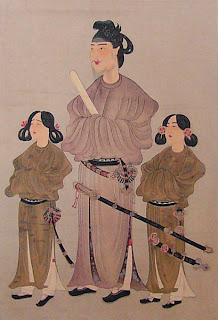In 1333, Ashikaga Takauji overthrew the
Kamakura dynasty and became shogun. He
moved his government back to Kyoto, into the Muromachi district. With the return of an imperial court, the
arts returned to the aristocracy, becoming elitist. Zen influence regained
confidence perhaps best demonstrated in monochromatic ink paintings which drew
inspiration from nature. Talents
considered typically Japanese flourished included landscape painting, classical
noh drama, flower arranging, and the tea ceremony. These disciplines, featuring
classic restraint and simplicity, were a direct result of Zen influence.
 |
| Kinkaku-ji Temple (1397) since restored |
Many of Kyoto’s famous gardens and temples date from this
period, which is considered the classical age of garden design. Integrating buildings into landscapes was an
important feature. The Golden Pavilion,
a Zen Buddhist temple Kinkaku-ji
(1397) is a beautiful example. As we
walked the gardens, we learned the temple’s tragic history - it was burned down
by a novice monk in 1950. Thankfully restored,
the temple’s top two storeys glitter with gilt making it a perfect picture reflected
in the lake.
 |
| Garden Art |
We were fortunate to visit the famous rock garden at Ryoan-ji Zen Temple before crowds
arrived. It was pleasant to be able to observe
the garden and get a feel for its Zen spirit.
The garden is quite small, has little vegetation (only moss) and is made
up of stones set in white gravel.
Fifteen stones are arranged in specific groups and the gravel is raked
daily by monks. The garden is meant to
be contemplated from a seated position on the veranda, where you are not meant
to see the garden in its entirety. This
ability only comes only with enlightenment.
 |
| Ryoan-ji Zen Temple Garden is even difficult to photograph |
Elaborate tea ceremonies came into being during this
period. Like many cultured activities,
the tea ceremony, conducted within a rigid framework of rules, provided guests an
opportunity to appreciate artisan skills.
In particular, the tea ceremony gave rise to new types of pottery. Cracks or chips were often repaired with
coloured lacquer, which added interest and value to a pot or cup.
 |
| Perhaps not quite in keeping with tradition but we learned so much |
Japan gradually became overwhelmed by ambitious noblemen
resulting in a general breakdown of law and order. The Onin War broke out in 1467 and Kyoto was
almost destroyed.





















